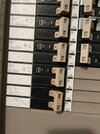davewill
Active Member
I'm not sure I buy his excuse. More likely he got a deal on, or got stuck with, a lot of 45a breakers and this saves him money. Anyway, since the UMC is limited to 32a, the 45a breaker is indeed, "OK". I'd say accept this, for now, but be aware that if you decide to use the outlet for other purposes, or change to a hard-wired wall connector, that the breaker may need to be upgraded to 50a. You could ask your electrician to please come back and change it as soon as he gets the correct breaker in, but I predict he will make another excuse why he can't do that.
One other option is to go ahead and buy the correct breaker yourself, and have him to come and install it for you.
One other option is to go ahead and buy the correct breaker yourself, and have him to come and install it for you.




